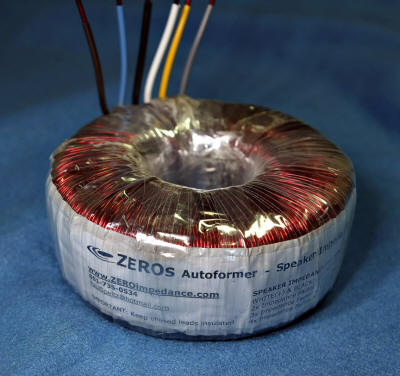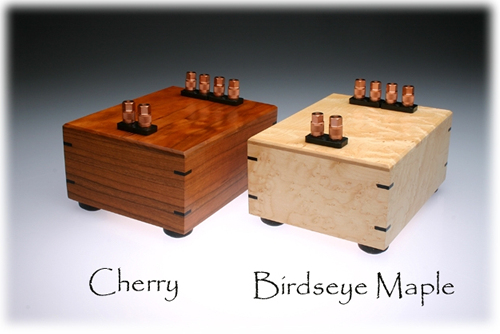You are reading the older HTML site
Positive Feedback ISSUE
july/august 2008
Paul Speltz's
Zero Impedance Autoformers
by Peter Davey

What are these things? They look like a part of a motor assembly! Well, in simple terms they are a multiple-wound transformer. Back in the day, you had a speaker with set load impedance, and hopefully an amplifier that was comfortable in that range. These days, there are a lot of exotic speakers out there that offer some amazing sound but at the cost of only being able to use a select few amplifiers. What if you're a tube guy? Are you SOL and stuck with a solid state amplifier?
These auto-formers ($450 a pair) are a very creative way to get past that barrier with minimal sound changes (if any.) Simply put, you can have a speaker with a 4ohm load and an amplifier with an 8ohm tap and make them work together using Paul's simple (but concise) impedance matching guides—it works on a set of multiplication factors and it works well.
This is just an example. There are several other sheets out there that will offer different factors, extremely versatile.
I decided to give these a shot in their advanced configuration, working with some Aluminum foil ribbons that were custom made. As you may or may not know, these ribbons when un-etched and not Kapton/Mylar backed can have some BRUTAL characteristics. The one I'm working with is almost a dead short to an amplifier. I have been using it directly coupled with a class-D amplifier when can handle the load but I didn't prefer the sound. I wanted to try this ribbon on a regular class A amplifier… and Paul came to the rescue.
Using the calculation graph, and with Paul's help, I was able to move a 0.3 (!) ohm load up to around 2.4ohms. Connected it to the amplifier and no magic smoke! Turned the volume up slowly and wow, music! It sounds glorious! Now since this was a naked ribbon with no shaping electronics whatsoever (direct-coupled) I had to put in a resistor to quiet it down a bit. A 10-watt .65ohm resistor was the ticket, brought it down about 9dB.
What about their sonic signature? Naturally these devices will change the sound. I don't think there is any way around that. Inserting any passive electrical component will do this, kind of how crossovers work. I'm not saying it's a bad or a good thing, you will have to determine this. Using the naked ribbon in this example did make it a bit dry sounding, but it was a ribbon! I had a friend try this on his JM Labs Mezzo Utopia (just for fun, these speakers are already quite efficient) and really didn't notice any sound degradation. I have a feeling this was because of the major multiplication factors involved with using a naked Ribbon.
Now my application is a bit "out there" but indeed this device works. It's really made for the common speaker to be run after its crossover and into the amplifier. Simply enough you can turn a 4ohm speaker into a 16ohm load for a smaller tube amp. This thing is a lot of fun! The possibilities are endless.

I've chosen the naked Autoformers as I don't mind having a bundle of wire sitting behind my speakers for this test, but if aesthetics are important (and they usually are) you can opt to get them put inside of a nice wooden box that Paul will provide...
ZeroImpedance.com http://www.zeroimpedance.com
